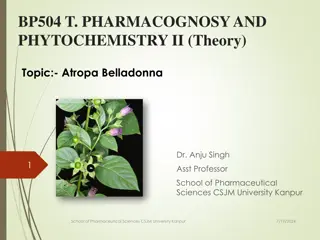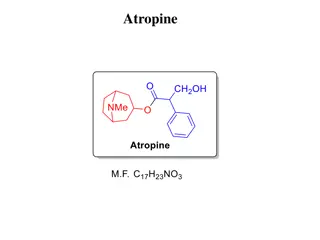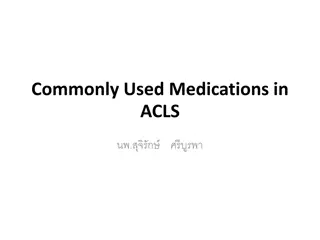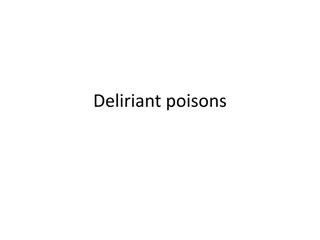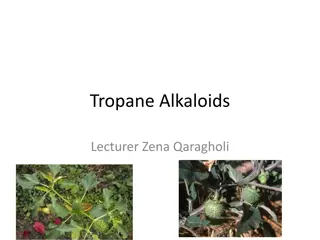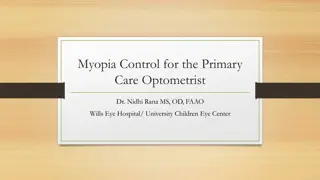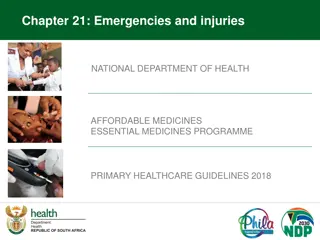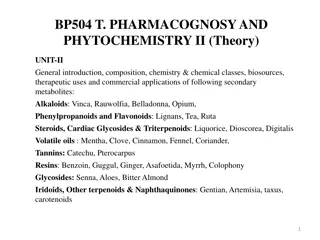Emergency Drugs and Their Mechanisms of Action
Learn about essential emergency drugs such as Adrenaline, Adenosine, Atropine, Furosemide, Calcium Gluconate, and Lidocaine. Understand their mechanisms of action, dosages, indications, and onset times to effectively manage cardiac arrest, anaphylaxis, arrhythmias, and other critical conditions.
3 views • 17 slides
Pharmacognosy and Phytochemistry II: Atropa Belladonna Overview
Atropa belladonna, commonly known as belladonna, is a plant rich in tropane alkaloids like atropine and scopolamine. This plant, belonging to the Solanaceae family, has various medicinal uses. Its distinct morphology and geographical sources make it a significant botanical specimen in pharmacognosy
0 views • 13 slides
Isolation and Analysis of Alkaloids: Atropine, Quinine, Reserpine, Caffeine
Alkaloids are extracted and isolated based on their basic character and solubility patterns using processes like Stas Otto. The general method includes treating plant material with solvents, extracting with ethanol, and separating bases using various techniques. Atropine, obtained from plants like A
2 views • 28 slides
Medication Dosage Calculations Practice
Practice calculating medication dosages for Tegretol, Theo-Dur, Atropine, and Heparin based on prescription orders and label information. Determine the correct amount of medication in milliliters or number of tablets to administer per dose. Enhance your pharmacy or healthcare skills with these dosag
0 views • 5 slides
Structural Determination of Tropine, Atropine, and Tropic Acid
Structural determination of compounds such as Tropine, Atropine, and Tropic Acid involves various tests and synthesis methods. Ester linkages, functional groups, and compound structures are analyzed through experiments like the Muller and Wislicenus synthesis. Different proposals and confirmations r
0 views • 12 slides
Commonly Used Medications in ACLS: Adenosine, Amiodarone, Atropine, Dopamine, Epinephrine
Adenosine is used for SVT, Amiodarone for VT/VF, Atropine for bradycardia, Dopamine for shock, and Epinephrine for cardiac arrest. Each medication has specific dosages and side effects. These drugs play crucial roles in advanced cardiac life support scenarios.
8 views • 16 slides
Understanding Datura Poisoning: Effects, Management, and Treatment
Datura, a genus of flowering plants, contains toxic alkaloids like scopolamine and atropine, causing severe symptoms ranging from dermatitis to hallucinations. Identifying datura seeds versus chili seeds, distinguishing signs of poisoning, managing fatal doses, and treatment methods like purgatives
0 views • 22 slides
Understanding Tropane Alkaloids in Datura Stramonium: Uses, Risks, and Chemistry
Datura stramonium, commonly known as Jimson weed, contains tropane alkaloids like atropine and scopolamine. These alkaloids have medicinal uses but can also be fatal if consumed in high amounts. The plant has been historically used for asthma relief and as a hallucinogen, but its toxicity can lead t
0 views • 22 slides
Understanding Myopia Control for Optometrists
Myopia, or nearsightedness, is a growing concern with increasing prevalence, especially among younger populations in Asia. Genetics, environmental factors like prolonged digital device use, and lack of outdoor activities contribute to its development. Controlling myopia is crucial to prevent risks l
0 views • 23 slides
Management of Cardiac Emergencies and Injuries: Guidelines and Updates
This document provides detailed information on managing cardiac emergencies and injuries, including bradycardia, tachydysrhythmias, and cardiac arrest in adults and children. It outlines specific interventions such as atropine, adrenaline, and synchronized cardioversion, with changes in protocols an
0 views • 15 slides
Exploration of Tropane Alkaloids: Atropine, Scopolamine, and More
Tropane alkaloids are a diverse group of secondary metabolites found in plants like Atropa belladona and Datura stramonium. Known for their medicinal properties, these alkaloids have notable therapeutic uses and can be chemically classified based on their structures and biosources. Atropine and scop
0 views • 10 slides

